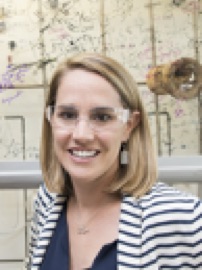Org. Synth. 2020, 97, 327-338
DOI: 10.15227/orgsyn.097.0327
Asymmetric Michael Addition of Dimethyl Malonate to 2-Cyclopenten-1-one Catalyzed by a Heterobimetallic Complex
Submitted by Nicholas J. Fastuca, Alice R. Wong, Victor W. Mak, and Sarah E. Reisman
1*
Checked by Kerry E. Jones and Richmond Sarpong
1. Procedure (Note 1)
A.
Preparation of GaNa-(S)-BINOL((S)-2) Solution (0.05 M).2 A flame-dried 1L, three-necked round-bottomed flask with 24/40 joints and a 1.5" Teflon coated egg-shaped magnetic stir bar is brought into a nitrogen filled glovebox (
Note 2). The flask is charged with
gallium (III) chloride (5.0 g, 28.4 mmol, 1.0 equiv) (Notes
3 and
4). The flask is sealed with three rubber septa (one of which is fitted with an internal temperature probe) brought out of the glovebox, and put under positive pressure of nitrogen via a needle attached to a nitrogen line. Another flame-dried 1L, three-necked round-bottomed flask with 24/40 joints and a 1.5" Teflon coated egg-shaped magnetic stir bar is charged with
(S)-(-)-1,1'-bi(2-naphthol) (
(S)-BINOL,
(S)-1) (16.26 g, 56.8 mmol, 2.0 equiv) (
Note 5). The flask is sealed with three rubber septa (one of which is fitted with a thermometer) and evacuated and backfilled with nitrogen three times (5 minutes under vacuum per cycle). A flame-dried 500 mL round-bottomed flask with a 24/40 joint and a 1" Teflon coated egg-shaped magnetic stir bar is charged with sodium
tert -butoxide (10.92 g, 113.6 mmol, 4.0 equiv) (
Note 6). The flask is sealed with a rubber septum and evacuated and backfilled with nitrogen three times (5 minutes under vacuum per cycle).
Anhydrous THF (200 mL) is added by syringe to the flask that contains the sodium tert-butoxide. The mixture is stirred until the solids dissolve (Notes 7 and 8). Anhydrous THF (172 mL) is added by syringe to the flask that contains (S)-1, and the mixture is stirred until all solids dissolve. Anhydrous THF (142 mL) and anhydrous Et2O (56 mL) are added by syringe to the flask of gallium (III) chloride, and the mixture is stirred until all solids dissolve.
The solution of
sodium tert-butoxide is transferred via a 20 gauge stainless steel cannula (Figure 1) to the stirring solution of
(S)-1 over ~30 min (the internal temperature is 24-25 °C), and the mixture is stirred at room temperature (24 °C) for 30 min. The resulting solution is then transferred via a 20 gauge stainless steel cannula to the stirred solution of
gallium (III) chloride over ~45 min, (the internal temperature is 25-26 °C), and the mixture is stirred at room temperature (24 °C) for 2 h. The mixture becomes cloudy over the course of the reaction. Upon completion, stirring is stopped and the mixture is allowed to settle, unperturbed, for 18 h (
Note 9).
Figure 1. A. Cannula transfer of sodium tert-butoxide solution to (S)-BINOL solution; B. Cannula transfer of sodium tert-butoxide and (S)-BINOL solution to gallium (III) chloride solution; C. Reaction to form (S)-2 before being allowed to settle; D. Catalyst solution after settling (photo provided by submitters, who used one-necked flasks and non-metal cannula)
B.
2-[(1S)-3-Oxocyclopentyl]-propanedioic acid, dimethyl ester (
(S)-5). A flame-dried 1L, three-necked round-bottomed flask with 24/40 joints and a 1" Teflon coated egg-shaped magnetic stir bar is charged with
sodium tert-butoxide (0.97 g, 10.1 mmol, 0.07 equiv). The flask is fitted with an oven-dried 250 mL graduated addition funnel and two rubber septa (one of which is fitted with an internal temperature probe). The flask is evacuated and backfilled with nitrogen three times (5 minutes under vacuum per cycle) before anhydrous
THF (22.5 mL) is added by syringe. The supernatant solution of
(S)-2 (288 mL, 14.4 mmol, 0.10 equiv) is measured by transferring to the addition funnel via a 20 gauge stainless steel cannula (Figure 2), and the solution is added to the suspension of
sodium tert-butoxide in two portions of 250 mL and 38 mL (the internal temperature is 23-24 °C) (
Note 10).
Dimethyl Malonate (
3) (16.5 mL, 144 mmol, 1.0 equiv) (
Note 11) is then added by syringe in one portion, followed by
2-cyclopenten-1-one (
4) (12.0 mL, 144 mmol, 1.0 equiv) in one portion (
Note 12). The mixture is stirred at room temperature (24 °C) for 46 h.
Figure 2. Reaction setup for Step B (photo provided by checker)
The reaction mixture is transferred to a 2L Erlenmeyer flask and then 1M aq.
HCl (900 mL) is added over ~5 min while the mixture is stirred. The mixture is transferred to a 4 L separatory funnel and extracted with
EtOAc (3 x 600 mL). The combined organic phases are washed with saturated aqueous
sodium bicarbonate (400 mL) (
Note 13). The aqueous
sodium bicarbonate wash is back-extracted with
EtOAc (200 mL). The combined organic phases are washed with brine (400 mL), dried over
Na2SO4 (~300 g) filtered through cotton and concentrated on a rotary evaporator (Notes
14 and
15). The crude product is transferred to a tared 100 mL round-bottomed flask with a 14/20 joint and a 0.75" stir bar is added. The product is dried on high-vacuum while heating to 75 °C with stirring for 1h (
Note 16). The crude product is obtained as a yellow oil (38.3 g).
Figure 3. Short path distillation setup with water condenser to cool condensate (photo provided by checker)
The flask of crude product is fitted with a short-path distillation head, cow-type distillation receiver, and three 100 mL tared flasks. The product is purified by distillation under reduced pressure (180 °C oil bath, vacuum line at 0.3 mmHg) (Figure 3) (Note 17). Three fractions are collected in the following quantities: 8.1 mg (70-110 °C), 23.46 g (110-125 °C), and 4.29 g (118-128 °C). Fractions two and three are combined to give (S)-5 as a colorless oil (27.7 g, 129 mmol, 90% yield, 99% ee) (Notes 18, 19, 20, 21, and 22).
2. Notes
1. Prior to performing each reaction, a thorough hazard analysis and risk assessment should be carried out with regard to each chemical substance and experimental operation on the scale planned and in the context of the laboratory where the procedures will be carried out. Guidelines for carrying out risk assessments and for analyzing the hazards associated with chemicals can be found in references such as Chapter 4 of "Prudent Practices in the Laboratory" (The National Academies Press, Washington, D.C., 2011; the full text can be accessed free of charge at
https://www.nap.edu/catalog/12654/prudent-practices-in-the-laboratory-handling-and-management-of-chemical. See also "Identifying and Evaluating Hazards in Research Laboratories" (American Chemical Society, 2015) which is available via the associated website "Hazard Assessment in Research Laboratories" at
https://www.acs.org/content/acs/en/about/governance/committees/chemicalsafety/hazard-assessment.html. In the case of this procedure, the risk assessment should include (but not necessarily be limited to) an evaluation of the potential hazards associated with
gallium (III) chloride,
2-cyclopenten-1-one,
dimethyl Malonate,
tetrahydrofuran (
THF),
diethyl ether, and
sodium tert-butoxide, as well as the proper procedures for vacuum distillation.
2. Preparation of
(S)-2 outside of the glovebox poses the hazard of generating
HCl (
g) upon exposure of
GaCl3 to ambient atmosphere. While this risk could be mitigated by weighing
GaCl3 directly into a dry flask filled with Ar (
g), attempts to use the resulting solution of
(S)-2 for the preparation of
(S)-5 gave variable levels of enantioselectivity (82-90% yield, 81-92% ee).
3.
Gallium (III) chloride (99.999%, anhydrous) was purchased from Strem Chemicals and used as received.
4. Caution:
gallium (III) chloride is hygroscopic and generates toxic
HCl (
g) when exposed to ambient atmosphere. Care should be taken to minimize exposure.
5.
(S)-(-)-1,1'-Bi(2-naphthol) (99%) was purchased from Oakwood Chemical and used as received.
6.
Sodium tert-butoxide (97%) was purchased from Sigma Aldrich and used as received.
7.
Tetrahydrofuran (
THF) and
diethyl ether (
Et2O) were purchased from Fisher Scientific and dried by passing through a solvent purification system with activated alumina columns.
8. A small amount of solid did not dissolve.
9. Storing the flask of catalyst solution elevated in the fume hood allows for direct cannulation, so that the solids are not disturbed from re-positioning the flask.
10. The remaining catalyst solution is sufficient for an additional run of step B on 8.6 g scale.
11.
Dimethyl Malonate (98%) was purchased from Sigma-Aldrich and used as received.
12.
2-Cyclopenten-1-one (95%) was purchased from Combi-Blocks and used as received.
13.
Sodium bicarbonate was purchased from EMD Millipore and used as received.
14.
Sodium chloride was purchased from J.T. Baker and used as received.
15.
Sodium sulfate (anhydrous) was purchased from EMD Millipore and used as received.
16. Heating under vacuum removes any residual starting material and makes for a cleaner distillation.
17. The reported pressure for distillation (0.3 mmHg) represents the full high vacuum being applied to the distillation apparatus.
18.
(S)-5 was characterized as follows:
1H NMR
pdf (500 MHz, CDCl
3) δ: 1.55 - 1.69 (m, 1H), 1.97 (ddd,
J = 18.2, 11.0, 1.5 Hz, 1H), 2.11 - 2.26 (m, 2H), 2.26 - 2.36 (m, 1H), 2.47 (dd,
J = 18.2, 7.6 Hz, 1H), 2.76 - 2.90 (m, 1H), 3.35 (d,
J = 9.4 Hz, 1H), 3.71 (s, 3H), 3.73 (s, 3H).
13C NMR
pdf (126 MHz, CDCl
3) δ: 27.5, 36.4, 38.2, 42.9, 52.7, 56.1, 168.5, 168.6, 217.0. IR 1019, 1156, 1205, 1245, 1269, 1325, 1436, 1734, 2957 cm
-1. HRMS: (ESI) calc'd for C
10H
14O
523Na
1 [M+Na] 237.0733, found 237.0733. [α]
23D = -87.5 (c = 1.18, CHCl
3).
319. The submitters distilled the product according to the following setup: The flask of crude product was fitted with a short-path distillation head. The product was purified by distillation under reduced pressure (180 °C oil bath, vacuum line at 0.2 mmHg). Four fractions were collected in the following quantities: 0.48 g (40-108 °C), 19.40 g (108-112 °C), 5.46 g (112-114 °C), 3.05 g (108-120 °C). The first and fourth fractions were combined and redistilled to give 2.16 g (108-112 °C), which was combined with the second and third fractions of the initial distillation to give
(S)-5 as a colorless oil (27.0 g, 126 mmol, 88% yield, 91% ee)
20.
(S)-5 was obtained in 98% weight purity as determined by QNMR
pdf with dimethyl fumarate (97%) as an internal standard.
21. Enantiomeric excess of
(S)-5 was determined by chiral high-performance liquid chromatography (HPLC) using a Perkin-Elmer Flexar HPLC system with a Chiralpak AD-H column (4.6 mm x 25 cm) eluting with 5% IPA in hexanes at a flow rate of 1mL/min over 30 minutes. The sample was prepared as a concentration of 10 mgs/mL in 10% IPA in hexanes and was sonicated for approximately one minute immediately before injection. A racemic standard was provided by the submitter, who prepared
(±)-5 using previously reported methods.
4 The submitters obtained enantiomeric excess of
(S)-5 by chiral supercritical fluid chromatography (SFC) using a Mettler SFC supercritical CO
2 analytical chromatography system (CO
2 = 1450 psi, column temperature = 40 °C) with a Chiralcel AD-H column (4.6 mm x 25 cm) eluting with 5 % isopropanol at a flow rate of 2.5 mL/min over 12 min.
22. A half scale run of this procedure provided
(S)-5 in 88% yield, 95% ee, and 99% weight purity.
Working with Hazardous Chemicals
The procedures in
Organic Syntheses are intended for use only by persons with proper training in experimental organic chemistry. All hazardous materials should be handled using the standard procedures for work with chemicals described in references such as "Prudent Practices in the Laboratory" (The National Academies Press, Washington, D.C., 2011; the full text can be accessed free of charge at
http://www.nap.edu/catalog.php?record_id=12654). All chemical waste should be disposed of in accordance with local regulations. For general guidelines for the management of chemical waste, see Chapter 8 of Prudent Practices.
In some articles in Organic Syntheses, chemical-specific hazards are highlighted in red "Caution Notes" within a procedure. It is important to recognize that the absence of a caution note does not imply that no significant hazards are associated with the chemicals involved in that procedure. Prior to performing a reaction, a thorough risk assessment should be carried out that includes a review of the potential hazards associated with each chemical and experimental operation on the scale that is planned for the procedure. Guidelines for carrying out a risk assessment and for analyzing the hazards associated with chemicals can be found in Chapter 4 of Prudent Practices.
The procedures described in Organic Syntheses are provided as published and are conducted at one's own risk. Organic Syntheses, Inc., its Editors, and its Board of Directors do not warrant or guarantee the safety of individuals using these procedures and hereby disclaim any liability for any injuries or damages claimed to have resulted from or related in any way to the procedures herein.
3. Discussion
Heterobimetallic complexes have been developed to mimic catalytic activity found in biological enzymes. The heterobimetallic framework allows catalyst complexes to act as both a Lewis acid and a Brønsted base, while the ligand framework orients sites of reactivity in close proximity to one another. Shibasaki and coworkers have demonstrated the utility of these complexes in the context of asymmetric catalysis.
5 For example, enantioselective versions of nitro-aldol,
6 Corey-Chaykovsky cyclopropanation,
7 and Michael reactions
2, 8 have been developed to give product in high enantiomeric excess.
In this article, we report the synthesis of Shibasaki's Ga-Na-BINOL complex (
(S)-2) on large scale, and its use as a catalyst for the asymmetric Michael addition of
dimethyl Malonate (
3) to
2-cyclopenten-1-one (
4). Asymmetric Michael reactions of stabilized nucleophiles with Michael acceptors provide reliable access to chiral building blocks, often with high enantioselectivity. Although a variety of chiral catalysts (e.g. iminium catalysts,
9 chiral Lewis-acid complexes,
10 hydrogen-bond donor catalysts,
11 etc.) and chiral auxiliaries (Evans oxazolidinone; chiral esters, amides, enamines and enoates
13) have been used to access enantioenriched Michael adducts, the Shibasaki Ga-Na-BINOL-catalyzed reaction is robust to scaling and works well for cyclopent-2-ene-1-one. The catalyst is easily prepared in a single step, and the chiral starting material,
(S)-1, is inexpensive and readily available in either enantiomeric series. In this article, we demonstrate the utility of
(S)-2 in the synthesis of Michael adduct
(S)-5 in 90% yield and 99% ee on 31 g scale. Column chromatography is not necessary for purification of
(S)-5. Instead, distillation provides multigram quantities of pure material in short order.
Appendix
Chemical Abstracts Nomenclature (Registry Number)
Gallium (III) Chloride (13450-90-3)
(-)-(1S)-[1,1'-Binaphthalene]-2,2'-diol (18531-99-2)
2-Methyl-2-propanol, sodium salt (865-48-5)
Propanedioic acid, dimethyl ester (3) (108-59-8)
2-CyClopenten-1-one (4) (930-30-3)
2-[(1S)-3-Oxocyclopentyl]-propanedioic acid, dimethyl ester (160115-23-1)

|
Nicholas Fastuca was born in Raleigh, NC and raised in West Chester, PA. He received his B.S. in Chemistry from The Pennsylvania State University in 2016, where he worked in the lab of Prof. Alexander Radosevich on biphilic organophos-phorus catalysis. Later in 2016, He began his graduate studies at the California Institute of Technology in the lab of Prof. Sarah Reisman. |

|
Alice Wong was raised in Oakland, CA and then moved to Pennsylvania where she obtained a B.A. in Chemistry from Swarthmore College. While there, she performed undergraduate research in organometallic chemistry with Prof. Robert Paley. She then moved to Sendai, Japan as a Fulbright Fellow to research organic methodology with Prof. Yujiro Hayashi at Tohoku University. She next went on to earn her Ph.D. with Prof. Sarah Reisman at the California Institute of Technology where her thesis research focused on natural products total synthesis. |

|
Victor W. Mak was born and raised in the Bay Area, CA. He obtained a B.S. in chemistry at University of California, Irvine, where he worked with Prof. Kenneth J. Shea on natural product total synthesis. Victor continued research in this field in the laboratory of Prof. Sarah Reisman at the California Institute of Technology, where he earned his Ph.D. in chemistry in 2017. He then moved back to the Bay Area to join the Discovery Chemistry group at Merck South San Francisco. |

|
Sarah E. Reisman earned a B.A. in Chemistry from Connecticut College in New London, CT, working in the laboratory of Prof. Timo Ovaska, and her Ph.D. in chemistry from Yale University, conducting research in the area of natural product synthesis with Prof. John L. Wood. As an NIH post-doctoral fellow, Sarah pursued studies in the field of asymmetric catalysis working with Prof. Eric Jacobsen at Harvard University. In 2008, Sarah joined the faculty at the California Institute of Technology where she is now the Bren Professor of Chemistry and a Heritage Principal Investigator. |

|
Kerry E. Jones was born and raised in the Bay Area, CA. She received her B.S. in chemistry from the University of California, Santa Barbara in 2018 where she worked in the lab of Prof. Armen Zakarian, researching stereodivergence in Ireland-Claisen rearrangements. She then returned to the Bay Area to begin her Ph.D. studies with Prof. Richmond Sarpong at the University of California, Berkeley.
|
Copyright © 1921-, Organic Syntheses, Inc. All Rights Reserved